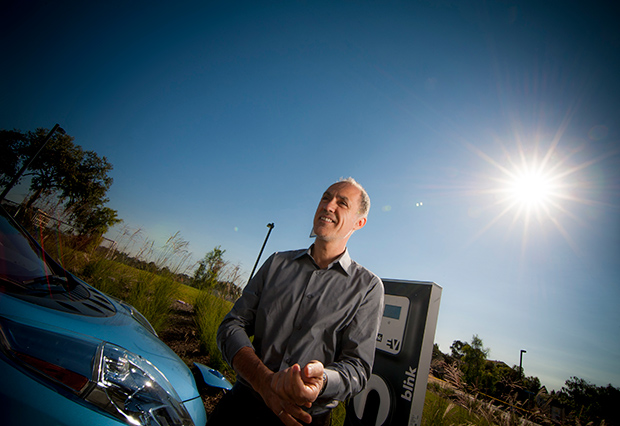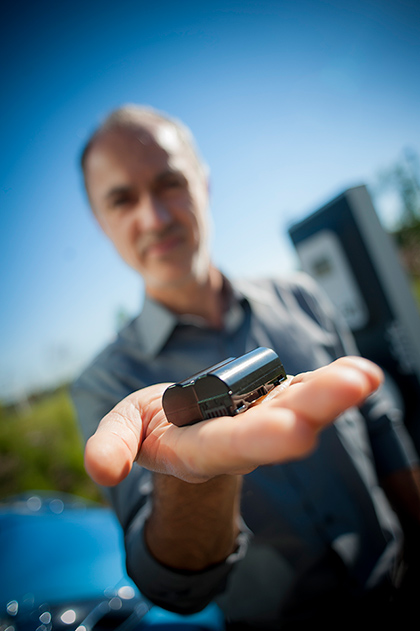By:
- Ioana Patringenaru
Published Date
By:
- Ioana Patringenaru
Share This:
The Quest for a Better Electric Vehicle Battery
UC San Diego engineers, scientists work across disciplines to tackle ‘grand challenge’ facing electric vehicles of future

Photos by Erik Jepsen/UC San Diego Publications
As the United States moves toward a switch from gas-powered to electric vehicles, one significant stumbling block remains: the massive batteries needed to run them. The devices remain fairly heavy, costly and slow to charge.
But several teams of UC San Diego engineers and scientists are working to solve the problems that stand in the way of electric vehicles becoming truly mainstream. One team is developing sophisticated algorithms to improve the way electric vehicle batteries run. Another is working to create new, more efficient and less costly materials for the devices.
UC San Diego to Provide Extensive Network of Electric Vehicle Charging Stations
By June 2013, UC San Diego is set to have the largest, most diversified portfolio of electric vehicle charging stations at any university in the world. The campus has received funding from the State of California and the federal American Recovery and Reinvestment Act for 56 stations.
San Francisco-based ECOtality will provide 25 electric vehicle charging stations and RWE, the second-largest utility company in Germany, will provide another 31 stations. Three of those units will feature DC fast chargers, which allow users to fully charge a battery in just 30 minutes, rather than the typical eight hours.
The first two operational public charging stations on UC San Diego’s main campus were unveiled in September at the new Structural and Materials Engineering building at the Jacobs School of Engineering. Five additional public charging stations are set to be up and running within a couple of weeks. Three are located at the Pangea Parking Structure and two at the East Campus Parking Structure.
“This is a great opportunity for the UC San Diego community to build upon our efforts to reduce the carbon footprint of the campus,” said Gary C. Matthews, UC San Diego’s vice chancellor for Resource Management and Planning. “More than half of UC San Diego’s commuters use an alternative form of transportation, contributing to the campus’s dedication to make sustainability a top priority in academics, research and campus-operations.”
More operational stations are available for the public beyond the main UC San Diego campus. The Bachman Parking Structure at Hillcrest is equipped with three stations. The Nimitz Marine Facility at Point Loma, the Englekirk Structural Engineering Center in Scripps Ranch and the Elliot Field research station each have one station.
UC San Diego also currently has six electric vehicle charging stations for the campus’ vehicle fleet.
“There is a tremendous amount of work that needs to be done here, considering that the batteries used in electric cars have much more stringent requirements on performance, reliability and safety,” said Shirley Meng, a professor of nanoengineering at the Jacobs School of Engineering. "The encouraging fact is that at UC San Diego, scientists and engineers from various disciplines are now working together to tackle this grand challenge.”
At the Laboratory for Energy Storage and Conversion, Meng is focused on vastly improving the energy storage capacity of lithium-ion batteries by combining advanced computation and modeling with synthetic and characterization experiments to develop new high energy density materials for one of the three main components of lithium-ion batteries: the cathode. The cathode is a limiting factor for achieving high energy density in today’s lithium batteries, she said.
The long-term goal is to develop lighter, smaller and more powerful batteries in response to demands for greater energy efficiency in cars and consumer electronics. Meng’s research is also being funded by the National Science Foundation for exploring new electrochemistry, such as sodium ion batteries.
Cost also is a major challenge in the field of battery research. To make these lighter, smaller, more powerful batteries scalable for consumer applications, researchers must bring down the costs of manufacturing the technology, which is measured in dollars per kilowatt hour. Another effective way of lowering the cost is to build batteries that can last longer and cycle more times.
The work of Miroslav Krstic a professor of mechanical and aerospace engineering at the Jacobs School, and of Scott Moura, a UC President's Postdoctoral Fellow in his lab, focuses on the latter. They have developed sophisticated estimation algorithms that allow lithium-ion batteries to run more efficiently, potentially reducing their cost by 25 percent and potentially allowing the batteries to charge twice as fast as is currently possible. In one instance, electric batteries could be charged in just 15 minutes.
The Department of Energy's Advanced Research Projects Agency - Energy (ARPA-E) has awarded the researchers at the Jacobs School of Engineering, the Palo Alto-based Bosch Research and Technology Center in Palo Alto as lead on the project, and battery manufacturer Cobasys, just under $4 million to develop the estimation algorithms technology for electric vehicle batteries. UC San Diego’s share of the grant is $415,000 for Krstic’s research group.
“This research is bringing the promise that, with advanced estimation algorithms that are based on mathematical models, batteries can be charged faster and can run more powerful electric motors,” said Krstic, who is also associate vice chancellor for research at UC San Diego.
Research and partnerships with industry
Krstic brings to the project extensive experience working with corporations and industry. He founded UC San Diego’s Cymer Center for Control Systems and Dynamics, which serves as a catalyst for interaction with industry and federal research sponsors; fosters collaborations with researchers from other fields; and recruits outstanding undergraduates, graduate students, postdocs and faculty in control systems.
As associate vice chancellor for research, he oversees academic organized research units, including centers and institutes, and academic research personnel matters, including postdoctoral and visiting scholars, and expansion of opportunities for early career research training and development. He will also assume responsibility for identifying and facilitating ways to enhance the core research facilities and services infrastructure of the campus.
As a researcher, Krstic is well known for developing the mathematical tools widely to suppress turbulence. That breakthrough has enabled advances in everything from automotive and jet engines to fusion reactors, lasers and charged particle accelerators.
He and Moura are taking a unique approach to making lithium-ion batteries more effective. Instead of monitoring voltage and current, they have designed sophisticated algorithms that can estimate what is physically going on inside the lithium-ion battery.
“We have the unique ability to address the difficulties in estimating the battery’s state of charge heads-on, at the electrochemical level,” said Krstic.
Current technology

Manufacturers usually rely on voltage and current to monitor the battery’s behavior and health. But those are very crude measures, said Krstic. Relying on these measures leads to over-designed, oversized batteries that weigh and cost more. They also take a long time to charge, compared with gas-powered vehicles. Toyota recently canceled mass production of its second all-electric car, the eQ, citing concerns over the viability of electric vehicle technology, including the amount of time vehicles take to charge.
Lithium-ion batteries are cylindrical and made of three sheets rolled together, very much like a jelly roll. One layer is the anode, another layer acts as a separator and yet another layer is the cathode. When the battery is fully charged, the lithium ions are stored at the anode. The battery is designed so that the ions want to move from the anode to the cathode, powering the device it’s connected to in the process. To know whether the battery is functioning properly, it’s important to know where the ions are in the anode. But that’s very difficult to measure, even with sophisticated equipment. The ions are usually lodged deep inside irregularly shaped particles within the anode.
Trying to estimate the particles’ charge by measuring only the voltage on the battery is similar to having the person that collects tickets at the entrance to a movie theater try to estimate which of the seats the patrons are taking by watching the speed at which the line at the entrance is moving, Moura said. In this analogy, the ions are patrons making their way to seats within each row, which represent the particles.
Using mathematics to estimate and control electrochemical phenomena
That’s where the estimation and control algorithms developed by Krstic and Moura come in. The algorithms allow researchers to estimate where the particles are. So, the movie theater can now be filled to capacity safety and efficiently. The model can also estimate how the health of the battery evolves over time—the equivalent of which seats are breaking down in the theater and need to be fixed or replaced.
The grant will allow researchers to refine the algorithms and to test them on actual batteries on testbeds developed by Bosch and Cobasys. They will estimate the charge distribution within the battery. Then they will estimate its state of health. Finally, researchers will devise a strategy to find optimal rates of charging and discharging batteries.
By testing their algorithms on electric vehicle batteries and comparing their performance to an electric battery run with existing technology, Krstic, Moura and colleagues plan to formulate a strategy to charge and use batteries to their maximum potential—safely.
“We monitor these crucial states directly,” said Moura. “It allows us to operate right at the battery’s limits without damaging it.”
Share This:
You May Also Like
UC San Diego is Strengthening U.S. Semiconductor Innovation and Workforce Development
Technology & EngineeringStay in the Know
Keep up with all the latest from UC San Diego. Subscribe to the newsletter today.



